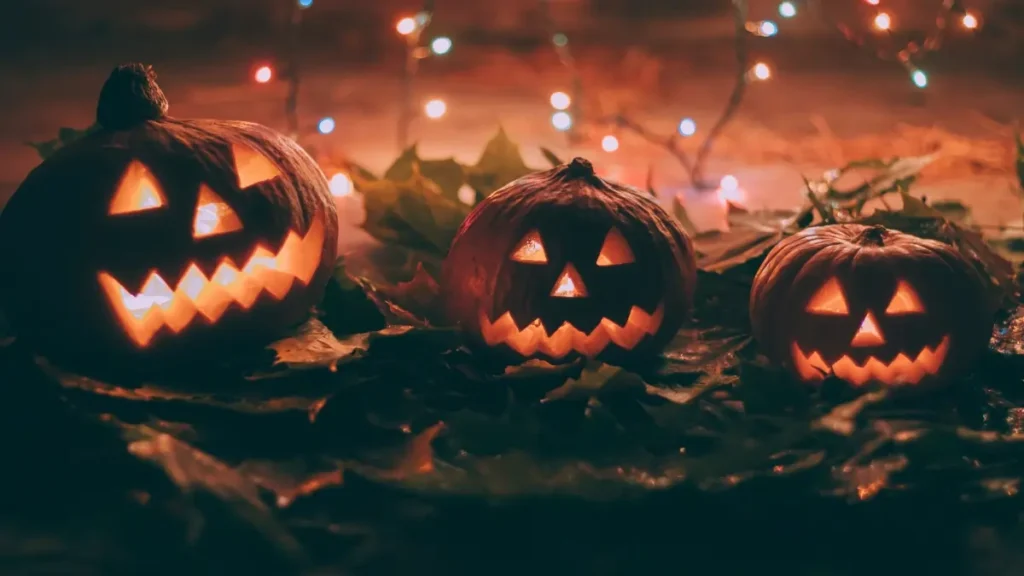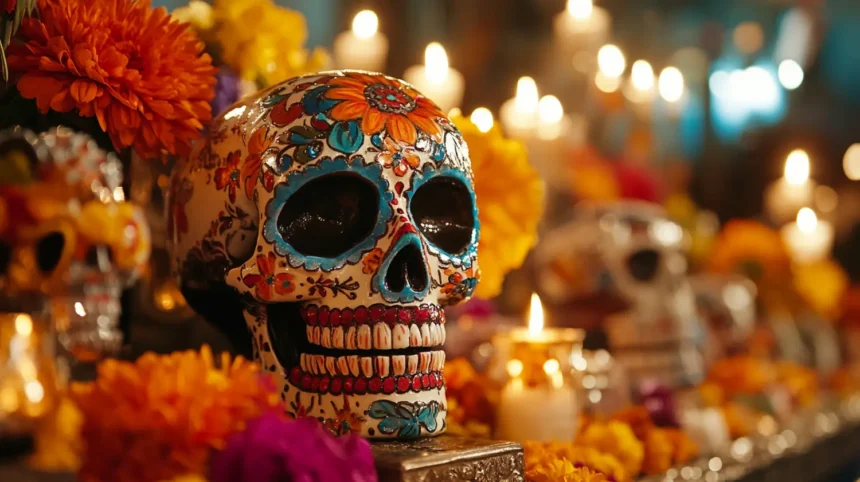Introduction:
Halloween is a holiday that many of us enjoy with costumes, candy, and spooky decorations. But have you ever wondered why do we celebrate Halloween? Over the centuries, Halloween has evolved from ancient religious rituals into a fun and festive celebration. Today, it blends elements of tradition, history, and modern entertainment. Interestingly, Halloween is one of the most celebrated holidays in the U.S., with Americans spending over $10 billion annually on costumes, candy, and decorations!
But why do we celebrate Halloween in the way we do? To answer this, we need to dive into the fascinating origins of the holiday, tracing it from its ancient roots to the modern-day customs we enjoy.
The Ancient Origins of Halloween:
The Celtic Festival of Samhain
The origin of Halloween can be traced back over 2,000 years to the ancient Celtic festival of Samhain. Celebrated on October 31st, Samhain marked the end of the harvest season and the beginning of winter—often seen as when the boundary between the living and the dead blurred. According to Celtic beliefs, spirits could roam the earth during Samhain, and people would light bonfires and wear costumes to ward off evil spirits.
Halloween traditions like carving jack-o’-lanterns and dressing up can be linked to these ancient practices. For example, Celts wore disguises to confuse wandering spirits, a precursor to our modern costume parties. The origin of Halloween lies deeply in these ancient rituals.
| Ancient Halloween Traditions | Modern Halloween Traditions |
|---|---|
| Wearing costumes to scare off spirits | Dressing up for fun and creativity |
| Lighting bonfires to ward off ghosts | Hosting parties with spooky décor |
| Leaving food offerings for spirits | Trick-or-treating for candy |
The Influence of Christianity on Halloween:
From Samhain to All Hallows’ Eve
When Christianity spread across Europe, it began to absorb many pagan traditions. One of the most significant religious influences on Halloween came in the 8th century when Pope Gregory III designated November 1 as All Saints’ Day, also known as All Hallows’ Day. The night before, October 31, became known as All Hallows’ Eve, eventually shortened to Halloween.
This blending of Christian and pagan customs is a key reason we celebrate Halloween today. The Church aimed to replace the festival of Samhain with a religious celebration, but many ancient Halloween customs—such as honoring the dead and wearing costumes—remained.
“Souling” and Trick-or-Treating
One of the most recognizable Halloween traditions is trick-or-treating. This practice may have roots in a medieval custom called “souling.” On All Hallows’ Eve, poor people would go door-to-door offering prayers for the deceased in exchange for “soul cakes.” This early form of trick-or-treating spread across Europe, and when immigrants brought these traditions to America, they evolved into the candy-gathering ritual we know today.
Halloween Traditions: Ancient to Modern
Costumes and Disguises
The practice of dressing up has remained a central feature of Halloween celebrations. Initially, costumes were worn to protect oneself from spirits. Today, Halloween costumes have evolved into creative expressions of culture, characters, and sometimes humor.
Jack-o’-Lanterns: From Turnips to Pumpkins
The tradition of carving jack-o’-lanterns originated in Ireland, where people would carve faces into turnips to ward off evil spirits. Irish immigrants found pumpkins more readily available and easier to carve when they came to America. Thus, the pumpkin jack-o’-lantern became an iconic symbol of Halloween.
Trick-or-Treating
As we’ve mentioned, the roots of trick-or-treating lie in ancient traditions like “souling.” Over time, the practice has transformed from a solemn, religious activity into a fun and family-friendly custom.
Halloween in the Modern Era
Global Variability in Halloween Celebrations
While Halloween is most widely celebrated in the United States, its popularity has spread across the globe. Countries like Canada, the United Kingdom, and Japan have adopted Halloween customs, though the celebrations may vary. For example, in Mexico, Día de los Muertos (Day of the Dead) occurs around the same time, focusing on honoring deceased loved ones rather than spooking them.
Another modern shift is the commercial aspect of Halloween. It has become a $10 billion industry in the U.S., driven by costume sales, decorations, and candy.
Modern Halloween Traditions
Halloween today has grown into a massive cultural event that blends ancient traditions, Christian influences, and modern entertainment. What makes it so popular across generations is its ability to appeal to different interests and age groups, creating a versatile holiday that is fun, thrilling, and socially engaging. But why do we celebrate Halloween with such enthusiasm in modern times? The answer lies in its unique mix of history and contemporary significance.
Halloween has evolved from a religious observance to a holiday all ages enjoy. Costume parties, haunted houses, and pumpkin carving contests exemplify how modern Halloween celebrations differ from their ancient roots. However, Halloween retains many elements of its original spirit-focused origins even in its current form.
Read also: Cultural Differences Between Canada and the USA: 5 Unexpected Contrasts
Why Do We Celebrate Halloween Today?
1. Blending Ancient Traditions with Modern Fun
At its core, Halloween stems from the ancient Celtic festival of Samhain, a time when people believed the boundary between the living and the dead blurred. Over the centuries, the holiday was shaped by Christian observances like All Saints’ Day while retaining many ancient traditions, such as costumes and an emphasis on spirits. These practices have carried forward and adapted to the contemporary world, evolving into the playful yet slightly eerie nature of modern Halloween.

For example, the ancient practice of wearing costumes to ward off evil spirits has transformed into an opportunity for people to express creativity and adopt alternate personas. Whether it’s a spooky ghost, a favorite superhero, or a pop culture icon, dressing up for Halloween has continued to capture the imagination of millions.
Why do we celebrate Halloween today? Because it offers a unique opportunity to connect with history while engaging in lighthearted, imaginative fun. Whether participating in a centuries-old tradition or a modern-day Halloween event, we’re connecting with a cultural tapestry that spans millennia.
2. Halloween as a Multi-Generational Celebration
One of the reasons we celebrate Halloween in such a big way today is that it appeals to a wide range of people. For children, Halloween is synonymous with trick-or-treating—a time to dress up, go door to door, and collect candy. This activity offers a sense of adventure and a chance for kids to enjoy community and participation. For many children, Halloween is one of the most anticipated days of the year.
Conversely, adults often gravitate towards costume parties, haunted attractions, or themed gatherings. For them, Halloween provides an opportunity to reconnect with their playful, imaginative side. The holiday allows adults to step away from their responsibilities and indulge in creativity through costumes or enjoy a good scare in a controlled, festive environment. Many also appreciate the opportunity to decorate their homes, host themed parties, or participate in community events.
This multi-generational appeal is a significant reason Halloween thrives today. It’s a celebration that brings families, friends, and communities together, each enjoying the holiday in their way.
Read also: The World’s Smallest Countries and Their Unique Geography
3. Psychological Thrill and Excitement
There’s an undeniable psychological appeal to celebrating Halloween. Humans are naturally drawn to things that scare them in safe and controlled environments. Haunted houses, ghost stories, and horror movies provide a thrill without danger, making Halloween a unique occasion to indulge in fear without consequence.
The excitement of wearing a costume also offers an escape from reality. Dressing up allows us to become someone (or something) else, even if just for a day. This escapism is especially appealing in today’s busy world, where adults and children alike may crave an outlet for self-expression.
Halloween also allows us to explore themes like fear, death, and the unknown in a festive and fun way. Rather than shying away from these heavy topics, Halloween brings them into the light, where we can laugh at them, celebrate them, and ultimately feel a sense of control over them. T
4. Modern Halloween Entertainment and Commercialization
Another reason Halloween is celebrated so much today is its commercial success. Over time, Halloween has grown into a multi-billion-dollar industry. In the U.S. alone, Americans spend billions on Halloween-related goods, including costumes, decorations, candy, and entertainment. Retailers capitalize on the holiday by rolling out Halloween-themed products months in advance, creating anticipation and excitement for the big day.
Halloween’s commercialization has expanded its appeal far beyond its origins. Today, haunted attractions, pumpkin patches, horror film marathons, and costume contests are staples of the Halloween season. This abundance of activities ensures something for everyone, whether they prefer spooky thrills or family-friendly fun.
5. Social Bonding and Community Engagement
Finally, why do we celebrate Halloween? Because it brings people together. Halloween has always been a communal celebration, whether through children trick-or-treating in their neighborhoods, family carving pumpkins, or friends attending costume parties. These shared experiences foster a sense of community and togetherness.
Halloween offers a chance to reconnect in a world where people are often disconnected from their neighbors or overwhelmed by daily life. It encourages us to engage with our communities, knock on our neighbors’ doors, and share in the spirit of fun. Even decorating your home for Halloween can inspire conversations and connections with those around you.
Read also: 10 Landmarks That Should Be Considered Wonders of the World
Conclusion
In conclusion, why do we celebrate Halloween? It’s a holiday steeped in rich history, blending ancient rituals with Christian traditions and evolving into the festive and spooky celebration we know today. From ancient customs like wearing disguises to modern Halloween traditions such as trick-or-treating, Halloween continues to captivate us with its fun, fright, and historical significance.
As we light our jack-o’-lanterns, don costumes, and fill our bags with candy, we’re partaking in a tradition that spans thousands of years. Halloween reminds us that the past and present can come together to create something truly magical.
Key Takeaway
Halloween is more than just a night of costumes and candy. It’s a holiday rich in history, traditions, and cultural significance, celebrating the intersection of the ancient and the modern.
FAQs About Halloween:
1. What is the origin of Halloween?
The origin of Halloween can be traced back to the ancient Celtic festival of Samhain, where people celebrated the end of the harvest and believed spirits roamed the earth.
2. How did Christianity influence Halloween?
Christianity merged with pagan traditions to create All Hallows’ Eve, which later became Halloween. This blending of cultures preserved many original customs, such as honoring the dead and wearing costumes.
3. Why do we carve pumpkins on Halloween?
Pumpkin carving is a modern evolution of an Irish tradition where people carved faces into turnips to scare off spirits. In the U.S., pumpkins were easier to carve, so they became the preferred medium.
4. How has Halloween changed over time?
Halloween has shifted from a religious festival focused on spirits and the dead to a community-centered celebration filled with costumes, candy, and entertainment.
5. Is Halloween celebrated worldwide?
Yes, Halloween is celebrated in many countries, though the customs and intensity of celebrations vary. Halloween blends with local traditions in some places, such as Mexico’s Día de los Muertos.





